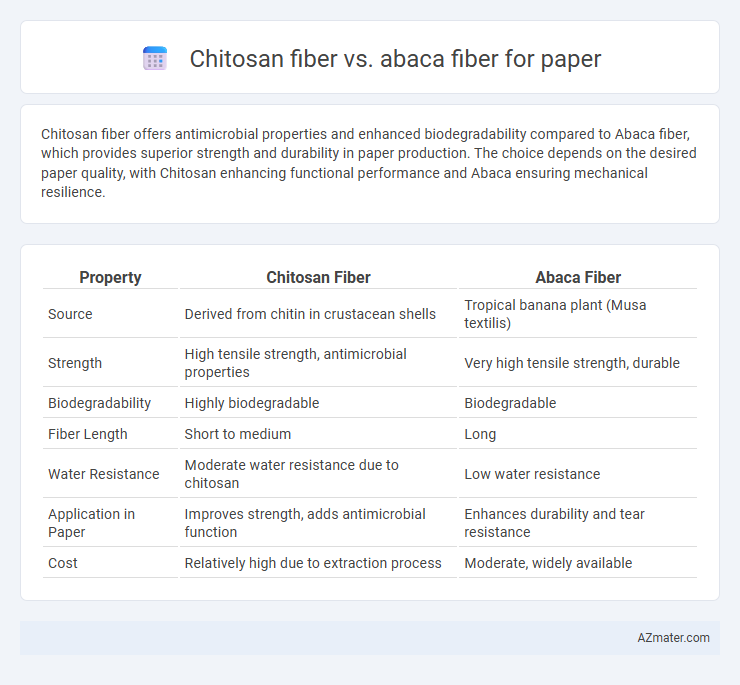Chitosan fiber offers antimicrobial properties and enhanced biodegradability compared to Abaca fiber, which provides superior strength and durability in paper production. The choice depends on the desired paper quality, with Chitosan enhancing functional performance and Abaca ensuring mechanical resilience.
Table of Comparison
| Property | Chitosan Fiber | Abaca Fiber |
|---|---|---|
| Source | Derived from chitin in crustacean shells | Tropical banana plant (Musa textilis) |
| Strength | High tensile strength, antimicrobial properties | Very high tensile strength, durable |
| Biodegradability | Highly biodegradable | Biodegradable |
| Fiber Length | Short to medium | Long |
| Water Resistance | Moderate water resistance due to chitosan | Low water resistance |
| Application in Paper | Improves strength, adds antimicrobial function | Enhances durability and tear resistance |
| Cost | Relatively high due to extraction process | Moderate, widely available |
Introduction to Chitosan and Abaca Fibers
Chitosan fiber, derived from chitin found in crustacean shells, offers biodegradable, antimicrobial, and film-forming properties ideal for specialty paper applications. Abaca fiber, sourced from the Musa textilis plant, is renowned for its exceptional tensile strength, flexibility, and natural resistance to saltwater damage, making it a preferred choice for durable paper products such as tea bags and banknotes. Both fibers contribute unique functional qualities to paper manufacturing, with chitosan enhancing bioactivity and abaca providing mechanical robustness.
Origin and Production Processes
Chitosan fiber is derived from chitin, primarily extracted from the exoskeleton of crustaceans such as shrimp and crabs, through a chemical deacetylation process involving demineralization and deproteinization. Abaca fiber originates from the leaf stalks of the Musa textilis plant native to the Philippines, produced via manual or mechanical stripping followed by drying and retting to extract strong, natural cellulose fibers. Both fibers undergo distinct production methods tailored to their biological sources, influencing their structural properties and suitability for specialized paper applications.
Chemical Structure and Composition
Chitosan fiber, derived from chitin, consists primarily of b-(1-4)-linked D-glucosamine units, providing amino groups that enhance antimicrobial and bonding properties in paper, whereas Abaca fiber contains cellulose, hemicellulose, and lignin with a high degree of polymerization and crystallinity, contributing to superior tensile strength. The presence of reactive amino functionalities in chitosan facilitates chemical cross-linking and improved fiber interfacing, contrasting with the mostly inert cellulose backbone of Abaca which relies on physical fiber reinforcement. Chitosan's unique cationic nature supports enhanced compatibility with anionic fillers and additives in paper production, while Abaca's lignocellulosic composition offers natural durability and biodegradability attributes optimized for traditional paper applications.
Mechanical Properties Comparison
Chitosan fiber exhibits superior tensile strength and flexibility compared to Abaca fiber, making it more suitable for high-performance paper applications requiring durability. Abaca fiber offers excellent tear resistance and stiffness, which enhances paper rigidity but may reduce pliability. Mechanical testing shows chitosan fiber blends improve elongation at break and tensile modulus, optimizing paper toughness and resilience.
Biodegradability and Environmental Impact
Chitosan fiber, derived from chitin in crustacean shells, exhibits superior biodegradability compared to abaca fiber, breaking down more rapidly in natural environments due to its biopolymer composition. Abaca fiber, sourced from the Musa textilis plant, provides good strength but decomposes slower, potentially contributing to longer environmental persistence in paper waste. The use of chitosan fiber in paper production supports sustainable practices by reducing landfill accumulation and promoting eco-friendly disposal, whereas abaca fiber offers a renewable resource but with a moderate ecological footprint.
Paper Forming Capabilities
Chitosan fiber exhibits superior paper forming capabilities due to its excellent bonding properties and high surface area, which enhance fiber-fiber bonding and improve paper strength. Abaca fiber, known for its long, coarse fibers, provides excellent tear resistance and durability but may require additional processing to achieve uniform sheet formation. The combination of chitosan's fine fiber network and abaca's mechanical strength results in enhanced paper quality with improved tensile strength and flexibility.
Strength and Durability in Paper Products
Chitosan fiber exhibits superior tensile strength and enhanced durability compared to Abaca fiber, making it highly effective for reinforced paper products. Its antimicrobial properties contribute to longer-lasting paper materials by preventing microbial degradation, while Abaca fiber, though naturally strong, tends to weaken under prolonged exposure to moisture. The integration of Chitosan fiber in paper manufacturing results in improved mechanical performance and extended product lifespan, outperforming traditional Abaca fiber in high-strength applications.
Cost and Availability Analysis
Chitosan fiber, derived from chitin in crustacean shells, offers moderate cost efficiency but faces limited availability due to reliance on seafood industry byproducts. Abaca fiber, sourced from the Musa textilis plant, is more abundant in tropical regions and generally exhibits lower raw material costs, making it economically favorable for large-scale paper production. The scarcity of chitosan fiber supply chains contrasts with abaca's well-established cultivation and harvesting infrastructure, impacting overall cost-effectiveness and market accessibility.
Industrial Applications and Suitability
Chitosan fiber exhibits strong antimicrobial properties and excellent biodegradability, making it suitable for high-performance paper products requiring enhanced durability and hygiene, such as medical packaging and specialty papers. Abaca fiber offers superior tensile strength and natural resistance to moisture, ideal for industrial applications like packaging, tea bags, and currency paper where durability and water resistance are critical. Industrial suitability depends on the specific application requirements, with chitosan fibers favored for functional paper uses and abaca fibers excelling in strength-intensive products.
Future Trends and Research Directions
Chitosan fiber exhibits promising biodegradability and antimicrobial properties, positioning it as a sustainable alternative to abaca fiber in advanced paper applications. Research trends emphasize nanocomposite enhancements and improved mechanical strength for chitosan-based paper products, aiming to address durability challenges that currently favor abaca fiber. Future developments are likely to focus on optimizing chitosan fiber extraction methods and integrating biofunctional additives to expand its usability in specialty and eco-friendly paper markets.

Infographic: Chitosan fiber vs Abaca fiber for Paper
 azmater.com
azmater.com